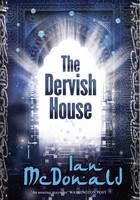7.6 /10 1 Votes7.6
Country Ireland Publication date July 27, 2010 ISBN 1-61-614204-9 | 3.8/5 Goodreads Language English Pages 410 Originally published 27 July 2010 Page count 410 Cover artist Stephan Martinière | |||||||||||||||||||||||||||||||||
 | ||||||||||||||||||||||||||||||||||
Similar Ian McDonald books, Science Fiction books | ||||||||||||||||||||||||||||||||||
The dervish house by ian mcdonald brief book chat
The Dervish House is a 2010 science fiction novel by Ian McDonald. The novel was shortlisted for the Arthur C. Clarke Award in 2011, and won the BSFA Award and the John W. Campbell Memorial Award in the same year. It was a nominee for the 2011 Hugo Award for Best Novel. The French translation La maison des derviches won the Planete-SF Blogger's Award in 2012.
Contents
Plot
The Dervish House is a near-future science fiction tale that follows a number of characters after a bus bombing incident in Istanbul during a week-long heatwave in April 2027. The characters have little contact with one another, other than they mostly reside or work in the neighborhood of an abandoned dervish house, Adem Dede, located in Eskiköy, within Istanbul's trendy Beyoğlu district. Most of the characters witness the bombing incident from different vantage points, and their actions are indirectly related to this event.
Each chapter alternates character perspectives. The primary character threads concern the following characters:
The story itself is a thriller, driven by the curious nature and mysterious motivations of the initial bombing, which resulted in no fatalities, other than the suicide bomber. Through the various character experiences it is revealed that the initial bombing was an experiment to test the effects of a hallucinogenic substance dispersed through a nanopowder vector on an unsuspecting population, in order to catalyze hallucinatory religious visions and usher in a cultural religious awakening. The story culminates when Necdet, Can, and Georgios thwart a final attempt by the terrorists to disperse the hallucinogen through the gas pipes of Istanbul.
Themes
The novel combines old world aesthetics (religious art and cultural history) with high-tech innovations (nanotechnology, auto-piloted cars, robotics), while also addressing the contradictory nature of Istanbul's cultural identity at a time when Turkey has been admitted to the European Union. The effects of progress and technology on postmodern society are illustrated by the variety of disconnected neighborhood characters. The idea of religion as a shared delusion is also introduced through Necdet's unwitting hallucingenic experience and his interactions with his neighborhood followers.
